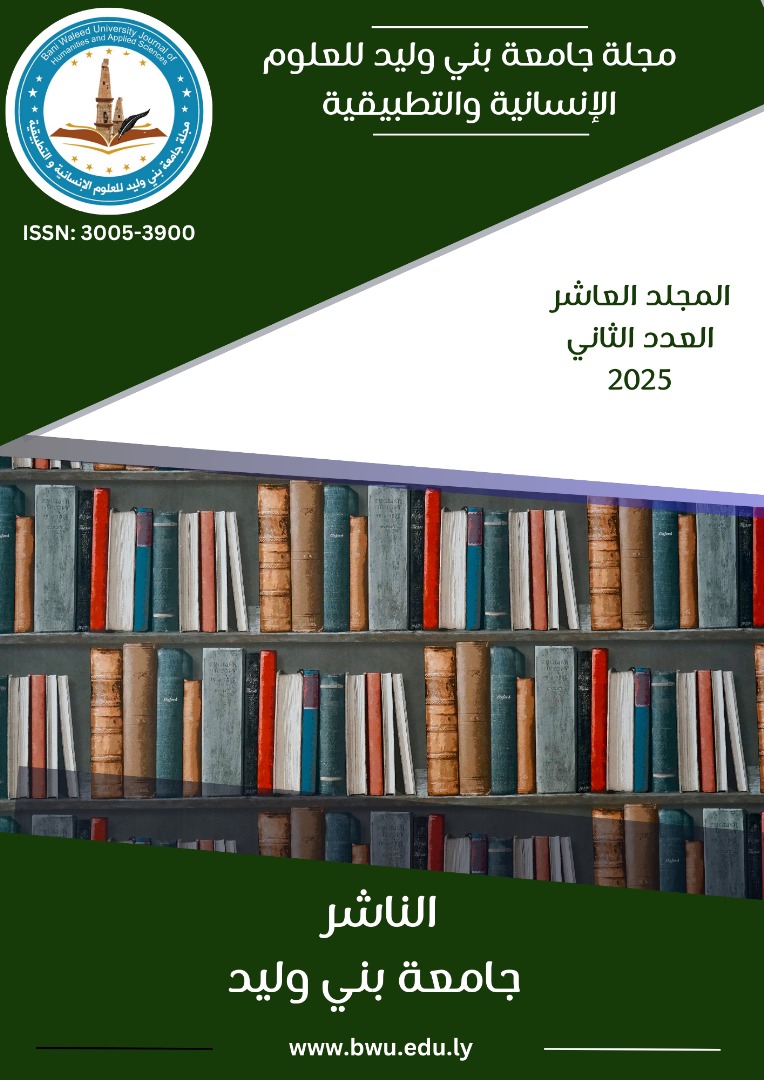Evaluation of irrigation water quality for some wells in Valley Zamzam region – Libya
DOI:
https://doi.org/10.58916/jhas.v10i2.741Keywords:
Water quality, salinity, sodicity, electrical conductivityAbstract
A study was conducted from November 2024 to February 2025 to evaluate the water quality of some wells used for irrigation in the Zamzam Valley area in northern Libya, which is located 150 km west of Sirte and 55 km south of the seashore. Water samples were taken from 10 randomly selected wells in the study area, for evaluation for irrigation purposes. Physical measurements and chemical analyses, including the determination of positive ions, were performed (Ca++, Na+, Mg++, K+) and negative ions (Cl-, HCo3-, So4--), and measuring electrical conductivity (EC), the hydrogen exponent (pH), and total dissolved solids (TDS), in addition to estimating some theoretically calculated indicators used in evaluating irrigation water, such as: (%SAR, AdjSAR, RSC, JR, Mg.R). The results obtained and compared with the standard criteria showed that the water of these wells has a high degree of salinity (C3) and low in sodium (S1), irrigation with such water leads to soil degradation, and requires special management, a good drainage system, and the cultivation of salt-resistant plants.
Downloads
References
Arabic References
Al-Zubaidi, Ahmed Haidar (1989). Soil Salinity - Theoretical and Applied Foundations. University of Baghdad - Bayt Al-Hikma Publications.
Al-Salawi, Mahmoud (1986). Groundwater: Between Theory and Practice. College of Agriculture, University of Tripoli, Libya.
Al-Faqi, Yousef Mohammed and Suwaid, Fathi Ali (2016). Shallow Groundwater (Unconfined Container Aquifer) in Some Wells in the Misrata Region and the Extent of Its Use in Drinking and Irrigation. Journal of Marine Sciences and Environmental Technologies. 2 (2): 15-33.
Khalil, Mahmoud Abdel Aziz (1998). Water Relations and Irrigation Systems (Sandy Soils - Protected Agriculture - Vegetable Crops). Maaref Establishment, Alexandria, Egypt.
Dariak, Gamal Saeed (2017). Evaluation of Irrigation Water Quality in Some Wells in Some Areas of Jabal Al-Akhdar and Al-Bayda, Libya. Journal of New Agricultural Research. 22 (3): 130-147.
Salem, N. A. (2015). A study on the health quality of groundwater in the Tripoli region of Libya. (Master's). Department of Preventive Medicine, University of Tripoli.
Salwa, H. A. (2017). Health risk assessment and pollution indicators of groundwater in the Al-Alam area of Salah al-Din Governorate, Iraq. Al-Muthanna Journal of Engineering and Technology, 5 (2), pp. 62–69.
Abdul Aziz, Abdul Razzaq Misbah, and Abdul Salam, Nasser Mawloud (2020). Assessment of the water situation in the area extending from the coast of the city of Sabratha to the Aqar area. Alexandria Journal of Agricultural Sciences 65 (1): 15–27.
English References:
Al-Badaii, F., Shuhaimi-Othman, M., andGasim, M. B. (2013). Water quality assessment of the Semenyih river, Selangor, Malaysia. Journal of chemistry, 2013(1), 871056.
https://doi.org/10.1155/2013/871056.ISSN: 2090-9071.
Ayers, R. S and Westcot, D.W. (1985). Water quality for agriculture. Irrigation and drainage paper (29 Rev. t.) FAO. Rome. Italy PP: - 1-13.
Ayers. R. S., and Westcot, D.W. (1994). Water quality for Agriculture. FAO. Irrigation & Drainage paper 29. ReV1.Rome-Italy. 178PP.
Ayers. R. S., and Westcot, D.W. (1994). Water quality for Agriculture. FAO. Irrigation & Drainage paper 29. ReV1.Rome-Italy. 178PP.
Barik, R.,andPattanayak, S. K. (2019). Assessment of groundwater quality for irrigation of green spaces in the Rourkela city of Odisha, India.Groundwater for Sustainable Development, 8, 428-438.https://doi.org/10.1016/j.gsd.2019.01.005. ISSN: 2352-801X.
Batarseh, M., Imreizeeq, E., Tilev, S., Al Alaween, M., Suleiman, W., Al Remeithi, A. M., ... and Al Alawneh, M. (2021). Assessment of groundwater quality for irrigation in the arid regions using irrigation water quality index (IWQI) and GIS-Zoning maps: Case study from Abu Dhabi Emirate, UAE. Groundwater for Sustainable Development, 14, 100611.
https://doi.org/10.1016/j.gsd.2021.100611.ISSN: 2352-801X.
Bauder, T. A., Waskom, R. M., Davis, J. G., & Sutherland, P. L. (2011). Irrigation water quality criteria (pp. 10-13). Fort Collins: Colorado State University Extension.
Black.C.A.. Evans, D.D.,White,J.L.,Ensminger,L.E., and Clark., 1965, Methods of Soil Analysis. part (1) and part (2), Am. Soc. of agron. Wisc., U.S.A.
Bohn, L.H., McNeal. L.B. and O' connor, A.G. (1979). soil Chemistry. Fourth. ed. JohnWiley&Sons, Inc. New York.
Chapman. H. and Pratt, P., 1961, Methods of Analysis for Soils, plants and waters. Unif. Of calif. U.S.A.
Cheng. K.L., and. B. R.h., 1951. Dettermination of Calcium and Magnesium in Soil and Plant Material. Soil Sci. V (72) PP: 449-453.
Dimple, D., Rajput, J., Al-Ansari, N.,andElbeltagi, A. (2022). Predicting Irrigation Water Quality Indices Based on Data‐Driven Algorithms: Case Study in Semiarid Environment. Journal of Chemistry, 2022(1), 4488446.https://doi.org/10.1155/2022/4488446.ISSN: 2090-9071.
Donnen., L.D. (1964). Notes on water Quality in agriculture. Water Sci&Engin. Paper: - 001 Dept of Water Sci&Engin. Univ of California.
Eaton. F.M. (1950). Significance of carbonates in irrigation waters. Soil Sci. 69:123–133.
El‐Dars, F. M.(2005). Evaluation of groundwater quality within a typical Egyptian village, North of Cairo, Egypt. Annali di Chimica: Journal of Analytical, Environmental and Cultural Heritage Chemistry, 95(5), 357-368.https://doi.org/10.1002/adic.200590040.ISSN: 1612-8877.
El Alfy, M., Lashin, A., Al-Arifi, N., and Al-Bassam, A. (2015). Groundwater characteristics and pollution assessment using integrated hydrochemical investigations GIS and multivariate geostatistical techniques in arid areas. Water Resources Management, 29, 5593-5612. https://doi.org/10.1007/s11269-015-1136-2.ISSN: 1573-1650.
FAO. (1994). Water quality for agriculture. Irrigation and Drainage Paper 29, Rev. 1. Rome. 174 pp.
FAO. (2006). World reference base for soil resources 2006. A framework for international classification, correalation and communication. Rome, FAO.
Fuentes-Rivas, R. M., Santacruz-De León, G., Ramos-Leal, J. A.,andMorán-Ramírez, J. (2023). Hydrogeochemical assessment and groundwater quality in a shallow aquifer: a case study of San Luis Potosí Valley, Mexico. Groundwater for Sustainable Development, 20, 100881.https://doi.org/10.1016/j.gsd.2022.100881.ISSN: 2352-801X.
Gomez, K.A, and Gomez, A.A. (1984). Statistical procedure for agricultural research. John Wiley and Sons. J. Agril. Res. 50(3): 357-364.
Hamad, S., & Fensham, R. (2025). Groundwater: An Important Resource of Urban Water Supply in Libya. In Water Resources of Libya: Challenges and Management (pp. 41-66). Cham: Springer Nature Switzerland.
https://doi.org/10.1007/978-3-031-80920-0_3.ISSN: 2364-6934.
Hamza, N. H.(2012). Evaluation of water quality of Diyala River for irrigation purposes. Diyala Journal of Engineering Sciences, 5(2), 82-98.
https://www.iasj.net/iasj/download/5ab8b960c5625257.ISSN: 1999-8716.
Harivandi. M. A. (1992). Interpreting Turf grass irrigation water test results. California Unv. Div of agric. & natural resources publication.
Hesse, P.R., 1971, A Text Book of Soil Chemical Analysis. Jhon Me London.
Islam, M. S. (2023). Irrigation Water Quality. In Hydrogeochemical Evaluation and Groundwater Quality (pp. 223-280). Cham: Springer Nature Switzerland.https://doi.org/10.1007/978-3-031-44304-6_7.
Kovda., V.A. (1973). Irrigation, Drainage and Salinity. Hutchinson Co. London. England.
MamRasoul, G.A. (2000). Steady water quality and its effect on nutrients availability for Corn in Sulaimania region. Msc. Thesis. Col. Agric. Sulaimania. Unv. PP: - 120.
Ogunfowokan.A.O., Obisanya., J. F, and OgunkoyaO.O. (2013). Salinity and Sodium hazard of three streams of different agricultural land use system in IIe- IBe, Nigeria. Appl. Water. Sci 3: 19-28.
Raghunath. H.M. (1987). Ground water, 2nd Ed. Wiley Eastern Ltd. New Delhi, India, PP. 344-369.
Reitemeier. R.f..1943. Semimicro analysis of saline solution. Indus..andeng. In chemi. Analyt. Ed ... V (15) pp: 393-402, ILLUS.
Richards. L. A. (1954). Diagnosis and improvement of saline and alkali soils. U. S. Dept of Agric. Handbook No 60, PP 69-82.
Richards. L. A. (1954). Diagnosis and improvement of saline and alkali soils. U. S. Dept of Agric. Handbook No 60, PP 69-82.
Shahinasi. E; and Kashuta, V. (2008). Irrigation Water quality and its effects upon soil. Balwois-Ohrid Republic of Macedonia.
Shaki, A. A., & Adeloye, A. J. (2006). Evaluation of quantity and quality of irrigation water at Gadowa irrigation project in Murzuq basin, southwest Libya. Agricultural water management, 84(1-2), 193-201. https://doi.org/10.1016/j.agwat.2006.01.012.ISSN: 0378-3774.
USSL Staff. (1954). Diagnosis and improvement of saline and alkali soils. USDA Handbook No 60. Washington DC, USA 160 pp.
Wilcox. L.V. (1955). Classification and use of irrigation waters. USDA, circular 469. Washington, DC.
Zurqani, H. A. (2025). Introduction to the “Water Resources of Libya: Challenges and Management”. In Water Resources of Libya: Challenges and Management (pp. 1-16). Cham: Springer Nature Switzerland. https://doi.org/10.1007/978-3-031-80920-0_1.ISSN: 2364-6934.












